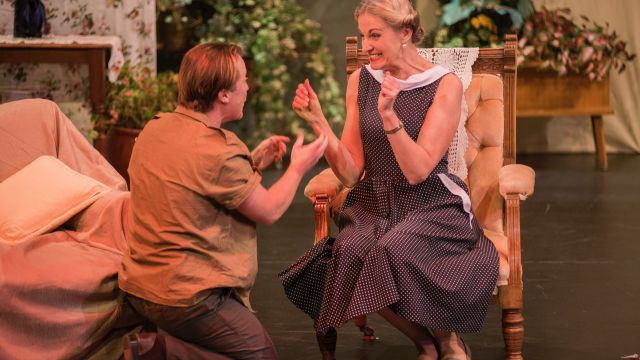

The worn period furniture - an upright piano, a dining table, a chaise longue, a buffet - look marooned against the vast translucent curtains that seem to rise up from rather than descend onto the stage, disappearing into an ominous, Greek column-like cornice. The kewpie dolls, jutting incongruously from vases scattered around the room, are of course present but there is little else in the way of clutter. There is no sign of the French windows, of the ‘tangle of plant life’ that enshrouds the house. Here, director Geordie Brookman and designer Pip Runciman have arrived at a sort of halfway house, the play’s naturalism sawn off at the edges rather than hollowed out. Only the bare minimum of Lawler’s detailed stage directions have been adhered to. This year marks the play’s 60th anniversary, this production the 125th since its premiere. The ‘shock of recognition’ that wowed Australian audiences in 1955 has long since died away, but the play’s universal qualities - most especially its textual discipline, intensity of feeling, and fully formed tragic effects - remain potent. The Doll has weathered many interpretations that have projected it beyond its naturalistic aesthetic and emphasised its tragic nature (Australian Nouveau Theatre in Melbourne’s 1983 version saw Olive and Bubba dressed in classical Greek draperies and a set design inspired by surrealist painter Paul Delvaux). When the curtain came down at the end, the theatre almost shook… It was the first Union Theatre Repertory play ever to play to an extended season. They took it to Sydney, then on Australian tour, then booked it into London’. The Doll’s naturalism, its colloquial idiom and emotionally charged though respectful evocation of working class life, formed the crucible in which Australian drama was forged.



‘They clapped every actor who came on and the roars which greeted Ray’s own entrance were tremendous. The question of which play was more deserving of production (the Board felt that The Torrents was the more complete of the two) was quickly subsumed by the Doll’s unprecedented success: ‘They clapped the house curtain when it went up, and they clapped the set,’ wrote Union Theatre manager Niall Brennan of the Doll’s opening night, 28 November 1955 in Melbourne. Unlike the other play that won first prize in the 1955 Playwright Advisory Board Competition - Oriel Gray’s The Torrents - Ray Lawler’s Summer of the Seventeenth Doll (just as often known simply as the Doll) has never been permitted to fade into obscurity.


 0 kommentar(er)
0 kommentar(er)
